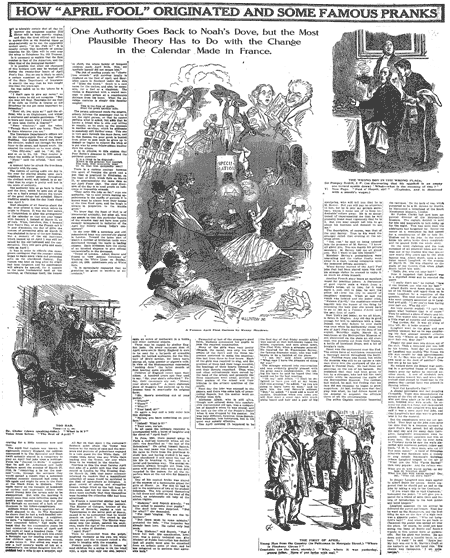Announcing a new blog: SundayMagazine.org
Short version:
I’ve launched a spinoff blog from Ironic Sans called Sunday Magazine. Every Friday I post the most interesting articles from the New York Times Sunday Magazine that was published exactly 100 years ago that weekend. You can get each week’s articles (probably one to six per week) by subscribing to the RSS feed, or following @sundaymagazine on Twitter, or by becoming a fan on Facebook.
It is not in any way affiliated with the New York Times. All of the Times articles I post are from before 1923, which means they are in the public domain.
Long version:
The New York Times Sunday Magazine is full of interesting articles about politics, science, crime, life, language, and human interest. It features fantastic writing and photography. It’s my favorite section in the paper.
It turns out that no matter how far back you go towards the supplement’s 1896 debut, the Magazine Section (as it was called back then) was always filled with amazing long-form articles, including many that are as interesting today as they were then. Some even more so. I stumbled upon this fact on April 1, when I began to get annoyed with every website’s need to pull some sort of prank. I wondered if companies did this sort of thing back at the turn of the last century. Searching for old articles about April Fool’s Day, I found this great article published in the Times on March 31, 1912:
(Note: All images of articles in this post can be clicked to enlarge; even bigger PDFs available via links below each image)
HOW “APRIL FOOL” ORIGINATED AND SOME FAMOUS PRANKS (PDF)
Everything about that article is wonderful. The writing style, the stories, and the illustrations are all quaint by today’s standards, but that makes it all so charming. It’s worth downloading the PDF to read it all, or any portion of it. Here is one of my favorite passages:
A hundred years ago [children] used to say, “Sir, your shoe’s unbuckled.” Today, their successors cry out, “Mister, your shoe’s untied!” A more elaborate piece of waggery has endured up to the present time practically its original form.“Sir, there’s something out of your pocket.”
“Where?”
“There!”
“What?”
“Your hand, sir!”Or again a boy and a lady enter into this dialogue.
“Ma’am, you have something on your face.”
“Indeed! What is it?”
“Your nose, ma’am.”In all cases the ultimate rejoinder is accompanied with a burst of laughter and the shout of “April fool!”
Another passage describes a prank pulled by the Evening Star newspaper in London, which comes closer to the kind of corporate pranks we see today, although a bit more mean-spirited:
On March 31, 1846, that paper solemnly informed its readers that a magnificent collection of asses would be exhibited in the Hall of Agriculture at Islington. A great crowd of staring and struggling human being filled up the hall long before noon, and not for some time did it dawn upon anybody that they themselves were forming the collection that had been advertised.
Could you even fill a room today by advertising a donkey exhibit? The article is full of stories like this, pranks and characters long forgotten. I thought I might sit on it for a year, and post it next April Fool’s Day. But I wanted to learn more about the article so I could post it with context. I needed to research the various background characters and then-famous pranksters mentioned in the article to provide annotation. And the more I thought about it, the more I began to wonder: could I find other interesting articles in the Times from around the same period?
I originally found the article on the NYTimes website, where all of their content pre-1923 is freely available, having fallen into the public domain. But their online archives are difficult to browse unless you have specific keywords you’re searching for. I noticed that this article was published on a Sunday, but I didn’t know what section it was in. I didn’t know if the Times even had a magazine back then. To find out, I went to the Microforms Room of the main branch of the New York Public Library.
Sure enough, the article was in the “Magazine Section” of the newspaper. I wondered what other interesting articles I could find the in the Magazine Section. So I rewound the microfilm one week and found the Magazine Section for March 24, 1912.
I think my jaw actually dropped when I saw this:
FRENCH SAVANT TELLS OF LIFE ON VENUS AND MARS: Conditions Resemble Those on the Earth (PDF)
What the hey-now? Check out those awesome drawings. They depict the zoologist Edmond Perrier’s descriptions of “frogs as big as cows” on Venus and “beautiful plumage” of birds on Mars. It’s almost like he imagined the world of Avatar 98 years ago, a bit closer to home. And look at those large-chested Martians with headlights on their fingertips!
Here’s how Perrier described Venus:
The dampness of the atmosphere on Venus favors the growth of ferns. The development of flowers from the more primitive forms of plants must be slow and probably has not yet been accomplished on Venus. This lack means the absence also of bees, butterflies, perhaps of ants and of other insects which depend partly or entirely on flowers for their food.
Venus, then, is the home of insects like grasshoppers, or dragon-flies, or roaches, grown to an enormous size; of large batrachians, frogs as big as our cows, of innumerable and gigantic reptiles like those which once filled our earth, ichthyosauri, pterodactyls, iguanodons. Man is absent; indeed the race of mammals may not yet have appeared, in even the humblest form.
That’s not the case on Mars, where people evolved similarly to Earthlings:
[The Martian] is very tall, because the force of gravity is so feeble; he is very fair, with blue eyes, because there is so little light or heat; his jaws are narrow and the top of his head is large, because he has been evolving away from the animals for a much longer period than we. The Martian noses would be long and the ears large. The Martian’s lungs and consequently his chest would be enormous, on account of the thin atmosphere, and his legs would be very slender, because little effort is needed to walk.
What a find.
This fantastic article seems like something out of Amazing Stories, and it’s just been sitting there in the New York Times Magazine archives for the past 98 years. As far as I can tell, nobody has written about it. A Google Search for the article brings up only one result: the PDF buried in the nytimes.com archive. It hasn’t been mentioned anywhere else that Google indexes, although a little more information is available about the French scientist. (I’ll have more to say about that on the new blog on March 24, 2012.)
I was eager to find other gems like this. But with so many years of archives available, where would I begin? I decided to start with the New York Times Sunday Magazine from exactly 100 years ago, and make my way forward. So I found the microfilm reel for April, 1910. In just the first week’s issue, I found several interesting articles. Zooming ahead, I found several more. Every week there were articles that made me think I just had to write a blog post about this treasure trove of fascinating reading material.
I started working on a post featuring some of the articles I found covering a two month period of Sunday Magazines. Omitting all but the ones I found most interesting, I was able to pare it down to just 30 articles. But that’s still too many to reasonably expect any of you to read at once. That’s 30 articles stuffed into one blog post.
And so I decided the best way to share my findings is to dole out a few of my favorite articles from each week on a new blog: SundayMagazine.org. I have a couple weeks’ worth of posts up, and the next two months’ worth already in the hopper. They range from historically interesting to downright bizarre. I hope that you’ll see it as a new source of reading material. You can find out about new articles, posted every Friday, by subscribing to the RSS feed, or following @sundaymagazine on Twitter, or by becoming a fan on Facebook.














Comments
I love this! What a great idea. Colorado has digitized many of its historic newspapers as well, and they are treasure troves of entertainment, especially if you are in the mood for some quirky and quaint humor.
Posted by: Lesley | April 13, 2010 11:15 PM
The PDF links 404.
Posted by: bbot | April 14, 2010 1:40 AM
This is just great. Even with the broken PDF-links ;)
Posted by: b°b | April 14, 2010 2:51 AM
PDF links fixed. Sorry about that.
Posted by: David | April 14, 2010 9:42 AM
I have been reading your blog for about two years now, and I find it to be consistently hilarious, entertaining, novel, and thought-provoking. And no blog post of yours has ever shown that to be true more than this one.
(You’re welcome.)
Posted by: Jesse | April 16, 2010 12:24 PM
I think these aliens may have been the principal inspiration for those in a Disney nonfiction film of the 50s, of which I cannot remember the name at the moment.
Posted by: John Woodruff Kennedy | April 24, 2010 10:47 AM
That’s a great find David, but don’t be so surprised. The idea of life on other planets, particularly Mars, was not considered remotely ‘bizarre’ until after the middle of the 20th century. Many eminent men of science argued that Mars was likely inhabited, particularly those who believed that the ‘canals’ visible on the surface of the planet indicated the work of intelligent beings. Sticking just with the NYT, for example, you might like to dig up these two articles:
‘The Light Flash From Mars: Prof. Pickering Makes A Statement in Regards to Alleged Signals’, New York Times, January 16 1901. (Not sure what page)
Mary Proctor, ‘Martians Built Two Immense Canals in Two Years’, New York Times Sunday Magazine, August 27 1911, section 5, p. 13.
The latter discusses the work of the most famous advocate of life (and canals) on Mars - Percival Lowell. It’s a great article.
As regards no one writing about this stuff - I’m currently writing a PhD on exactly this subject, namely: the Mars canal controversy in the popular press. If you come across anything more to do with Mars, please email me (as I’m yet to find the time to browse the NYT at any great length). My email is uri_3 (at) yahoo.com. Thanks. And keep up the great work - I can’t wait to see what other cool stuff you find.
Posted by: Lancelot Hogben | April 24, 2010 1:29 PM
I think this is a great idea, will check it out. Love to read old time articles and news story. Neat idea.
Posted by: Zengirl @ Heart and Mind | June 24, 2010 5:22 AM
check out Vesta la Viesta. NYT and Frank Leslie’s Illustrated Monthly:
http://bit.ly/9CIXwE
lectured on her visits to planets,etc
Vesta La Viesta says she was taught the “wireless” soul kiss by her affinity on the planet Neptune. NY1906.
Posted by: J | July 17, 2010 9:48 AM